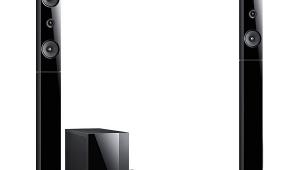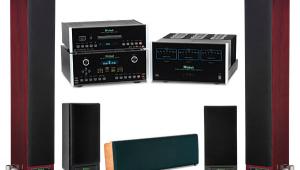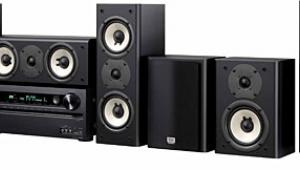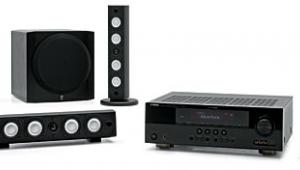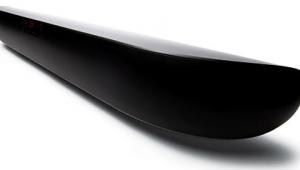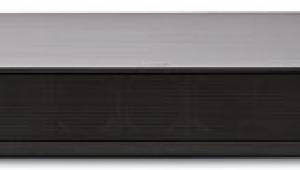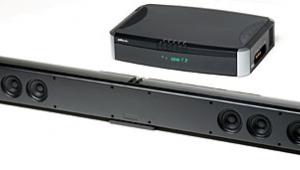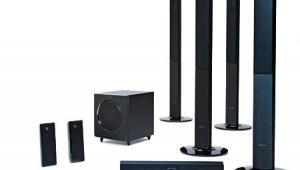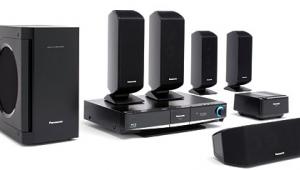Sony DAV-LF1 DVD Platinum Dream System Page 2
Sony uses an infrared-light technology called Digital Infrared Audio Transmission because it delivers uncompressed digital audio signals that are immune to interference from most other wireless devices. Other manufacturers have invested in radio-frequency technologies used by cordless phones, such as 900-megahertz transmissions, for similar purposes, and Bluetooth technology also offers promise for home theaters.
A radio signal travels through solid objects like walls and doors, but it's more likely to pick up interference. An IR signal, as anyone with a remote control knows, can't pass through a box of tissues, but interference is much less likely. The IR transmitter thus needs a clear path to the IR receiver built into the surround speaker. For those instances (like mine) when the speaker is placed behind a solid object, like a chair, Sony provides yet another IR receiver, a matching clamshell that can be placed on a wall, shelf, or anyplace that gives it a clear view of the IR transmitter.
In those cases, the DAV-LF1 uses four wires for the surrounds—two for the IR transmitter/receiver system, one that connects the two speakers, and the power cable for the speaker's built-in IR receiver. That's double the wires in a conventional wired system.
With all the umbilical cords, transmitters, and receivers, setting up the DAV-LF1 felt a little like delivering a baby. It was particularly painful balancing the speaker levels. The DAV-LF1's onboard test tones were too short, and I couldn't use the Avia Guide to Home Theater test disc simultaneously with the DAV-LF1's onscreen menu. In addition, there were no individual volume controls for the left and right channels, only a left/right balance. It wasn't pretty.
I did learn from the CD-Check test disc that the DAV-LF1 qualified as very good at correcting errors caused by CD manufacturing and surface imperfections like scratches. A low-frequency sweep tone on the Avia disc also demonstrated that, like a lot of HTIB systems, the DAV-LF1 has the bass output of a good bookshelf speaker, with bass extension to what sounded like about 55 hertz in my room.
 Its video performance lacked the dexterity of many standalone players. In progressive-scan mode, it quickly revealed that it takes awhile to recognize 3:2 pulldown by failing to lock onto the Snell & Wilcox Zone Plate test pattern on Digital Video Essentials. The DAV-LF1 also performed poorly on a 6.75-MHz circle test pattern, indicating it might not have the guts to produce an image's finest details.
Its video performance lacked the dexterity of many standalone players. In progressive-scan mode, it quickly revealed that it takes awhile to recognize 3:2 pulldown by failing to lock onto the Snell & Wilcox Zone Plate test pattern on Digital Video Essentials. The DAV-LF1 also performed poorly on a 6.75-MHz circle test pattern, indicating it might not have the guts to produce an image's finest details.
In practice, however, the DAV-LF1 committed no egregious errors in progressive-scan mode that would alarm the casual viewer. For instance, it negotiated all of the tricky lines in Gladiator from the chapter 12 aerial view of the Colosseum, as seen from the official Roman Empire blimp. It also displayed the Star Wars Trilogy set in all of its reinvigorated glory.
The Quiet Type?
The DAV-LF1's sound (or, more specifically, the amount of it) was worrisome. In my small home theater, I could coax a peak volume of only about 88 decibels on the remastered Empire Strikes Back. That's plenty for these ears, but maybe not enough for others. In a bigger space, the DAV-LF1 might not do the job.
The wireless surrounds also have a distinctive, not-always-natural sound, although they never lost a signal unless I deliberately blocked the path from the IR transmitter. During The Empire Strikes Back, the surrounds were not as crisp as the front speakers. The sound seemed distant, somewhat recessed. The Last Castle, the Robert Redford/James Gandolfini go-directly-to-jail film, was a slight improvement, although the surround speakers retained a certain dullness. Die Another Day's opening was another story. It sounded almost...wired. Saved, again, by Bond.
Despite these variations, the DAV-LF1 always had a genial, almost nondescript sound. Each main speaker has a 4-inch driver in a cabinet that's only 2 inches deep, and the system never sounded boomy or out of control. Conversely, it never sounded overly harsh. To someone who has never owned a 5.1 system, which appears to be the DAV-LF1's target audience, its inoffensiveness might be its biggest sonic attraction.
As Shirley Horn sang "The Best Is Yet to Come," I could almost believe it. The DAV-LF1 captured her ultra-smooth delivery, but in DPLII the surround vocals echoed unnaturally. The remote, by the way, has no dedicated control for DPL, SACD, or any processing mode. To access an SACD's two-channel layer, you must hit the remote's audio button repeatedly or go straight to the onscreen menu.
Likewise, scrolling through the soundfields requires using the Auto Format Direct/Mode buttons. You can't adjust the DPLII Music and Movie modes, but Sony offers an assortment of their proprietary Digital Cinema Sound EX movie modes and a Headphone Theater surround mode for private listening.
Not surprisingly, the DAV-LF1 sounded best when loaded with an SACD. "Rolling Log"—from a Telarc multichannel hybrid showcase for Eric Bibb, Rory Block, and Maria Muldaur called Sisters & Brothers—sounded good all the way around (including the surrounds). It's a full, rich, soulful exercise in the blues. With some material, the DAV-LF1 had trouble with tonal balance: "Funky Hotel Blues" from Sonny Rollins' The Sound of Sonny, a Fantasy SACD hybrid, was top-heavy with Rollins' tenor saxophone, leaving Paul Chambers' bass too far in the background. Again, this was likely related to the DAV-LF1's lack of bass output.
Without question, the Sony DAV-LF1 gives owners of wall-mounted flat panels who cherish their floor space an upscale surround sound alternative to their TV's lowly stereo speakers. It's a growing, but still small, demographic that Sony seeks with the DAV-LF1. Buying a wireless home theater, it seems, comes with some strings attached.
Highlights
• A dead-on match for flat-panel televisions
• Suitable for hanging—start clearing some wall space
• Beyond the beauty, a likable, smooth, and easy sound
